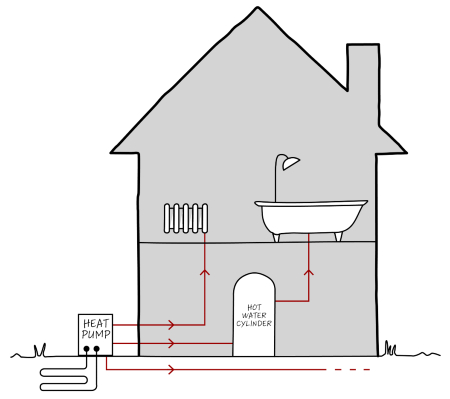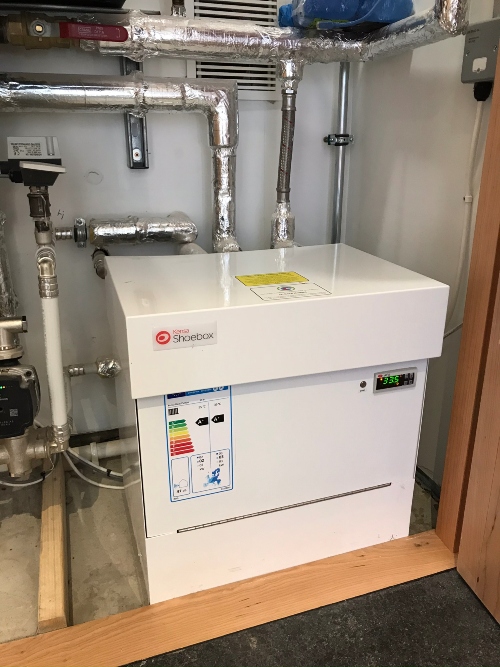Ground source heat pump
Ground Source Heat Pumps use the solar heat energy stored in the ground to provide heat and hot water for a home. ‘Ground source’ can mean boreholes, slinkies, or a ‘water source’ (open-loop connection to aquifer, lake, or river). Borehole systems require deep vertical holes to be dug, whereas alternative systems are shallower, but cover a wider horizontal area.
They are an alternative to conventional boilers, but operate at lower temperatures, so note that they can be unfeasible without insulation improvements or changes to heat emitters. They are not a direct alternative to combination boilers, as hot water storage must be introduced.
As they operate at lower temperatures, they are well-suited to large heat emitters such as underfloor heating or conventional wet radiator systems.. The system runs at a lower temperature than gas or oil powered systems and it is important that a full heat calculation for the home is undertaken to ensure correct specification of the heat pump and sizing of radiators and hot water tank.
Ground source heat pump installation
Ground sourced heat pumps do not burn fossil fuels and are classed as renewable technology. The system does require electricity to operate. Carbon efficiency depend on how green your electrical supplier is.
Buildings should be well-insulated and the ground source heat pump should be combined with other energy efficiency measures.
For an average home, the upfront cost of a ground source heat pump installation will be more than a conventional boiler. You should also be aware of potential additional costs of changes to heat emitters or the addition of hot water storage.
Compared to air source heat pumps, ground source heat pumps potentially have lower maintenance and replacement costs, although the upfront cost tends to be higher.
Boreholes can have a detrimental impact on archaeology. Slinkies, an alternative to boreholes, can be even more intrusive in some cases. An archaeological assessment should be undertaken by a professional prior to work commencing.
Ecology issues such as tree roots and any effect on the temperature of the soil should be checked by a professional prior to work commencing. The ground array designer should size the array to avoid temperatures that would be detrimental to roots.
Consideration should be given to the location of the internal plant which take up a large amount of space and could require you to break through building fabric. They do not require a flue or gas supply, but do require a flow and return pip connection from the ground outside into the house.
A ground source heat pump slinky awaiting burial. Photo copyright: The Centre for Sustainable Energy.
Listed Building Consent is required where it involves alterations to the listed building.
Boreholes need to have regard to the County of Avon Act (1982), which protects the source of the Bath hot springs. Contact us for more detailed advice.
Older properties often contain microbore pipework, which may need to be replaced as it is not usually compatible with a heat pump. Care should be taken when planning pipe runs.
When used for space heating, heat pumps work most efficiently with under-floor heating. This is unlikely to be appropriate under undisturbed, historic floor surfaces. However, where this is not the case, such as where there is a poor quality modern, replacement flooring, the installation of under floor heating may be possible. In which case it is recommended that limecrete is used which can be used in conjunction with insulation and under floor heating systems whilst allowing the transfer of moisture.
Care should be taken when drilling boreholes adjacent to any particularly fragile structure to avoid damage.
We support the use of ground source heat pumps where appropriate.
In the light of the Climate Emergency, we will generally permit and encourage alterations on listed buildings, with special regard to the the following:
- Preserving the building, its setting or any features of special architectural or historic interest which it possesses
- Preserving or enhancing the character of a conservation area
- Respecting the significance of any non-designated heritage asset
Energy Efficiency and Historic Buildings: Ground source heat pumps guidance from Historic England
A guide to ground source heat pumps from the Energy Saving Trust
The Centre for Sustainable Energy has also produced guidance on Ground source heat pumps



